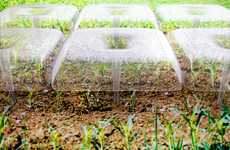
The Dewdrop Tree Was Designed to Combat Desert Water Shortage
Vasiliki Marapas — May 15, 2015 — Eco
References: youtube & yankodesign
The Dewdrop Tree is almost a call to action for other designers to address the water shortage that many desert and third-world countries are experiencing.
Though policies are in place to help solve this problem, the restrictions of cost and technical power keep them from being impactful. The Dewdrop Tree, on the other hand, is designed to solve the water shortage more directly.
The design takes advantage of the fact that, in clear desert climates, dewdrops are likely to form. The problem is, because of the heat, these drops of moisture disappear almost instantly. The design employs the use of PCM (Phase Change Material) to collect large amount of these dewdrops, ultimately proposing a more effective solution. In effect, the Dewdrop Tree functions much like a regular tree collecting water.
Though policies are in place to help solve this problem, the restrictions of cost and technical power keep them from being impactful. The Dewdrop Tree, on the other hand, is designed to solve the water shortage more directly.
The design takes advantage of the fact that, in clear desert climates, dewdrops are likely to form. The problem is, because of the heat, these drops of moisture disappear almost instantly. The design employs the use of PCM (Phase Change Material) to collect large amount of these dewdrops, ultimately proposing a more effective solution. In effect, the Dewdrop Tree functions much like a regular tree collecting water.
Trend Themes
1. Water Collection Innovations - The Dewdrop Tree showcases a new approach to collecting water in desert climates by utilizing PCM technology.
2. Sustainable Design - The Dewdrop Tree highlights the potential for sustainable design solutions in addressing water shortages.
3. Technological Advancements in Water Conservation - The use of PCM in the Dewdrop Tree demonstrates the potential for advanced materials to revolutionize water conservation efforts.
Industry Implications
1. Architecture and Design - The Dewdrop Tree presents opportunities for architects and designers to create innovative structures that collect and store water in arid regions.
2. Environmental Conservation - The development of water collection innovations like the Dewdrop Tree aligns with the goals and opportunities within the environmental conservation industry.
3. Technology and Materials Science - The utilization of PCM in the Dewdrop Tree highlights advancements in materials science that can be applied to various industries, including water conservation and sustainability.
1.9
Score
Popularity
Activity
Freshness















